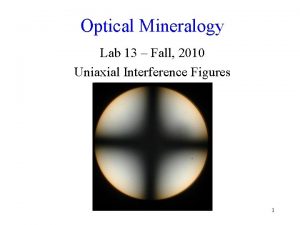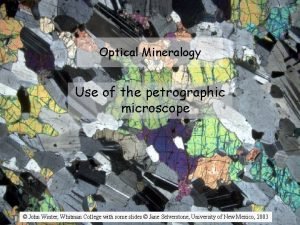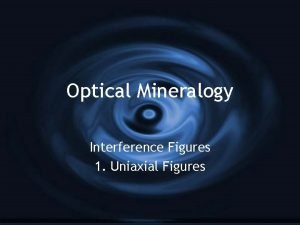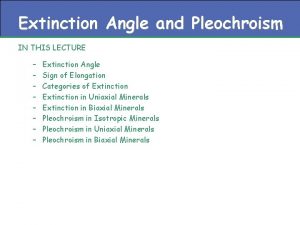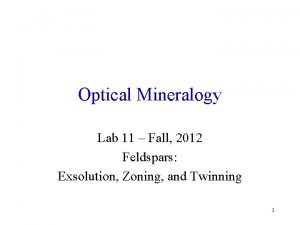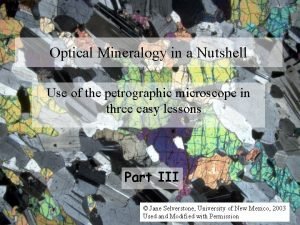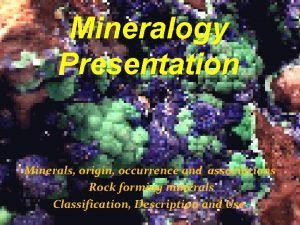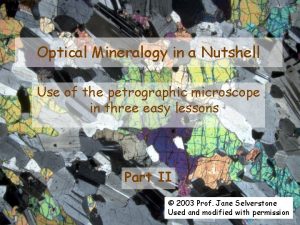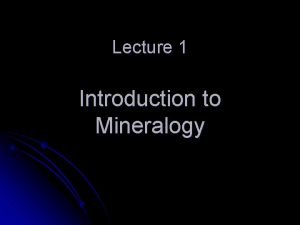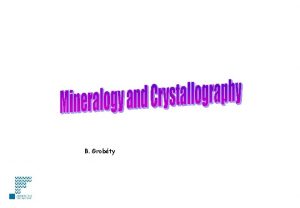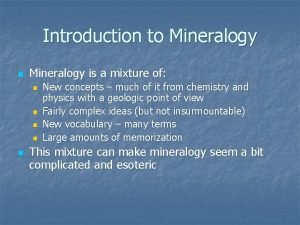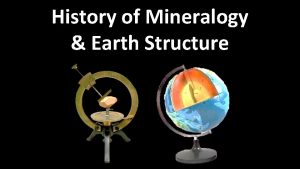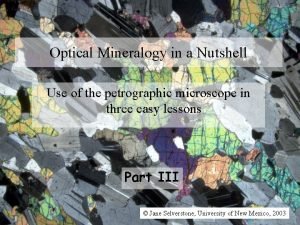Optical Mineralogy Optical mineralogy is the study of











- Slides: 11

Optical Mineralogy Optical mineralogy is the study of minerals and rocks by measuring their optical properties. Most commonly, rock and mineral samples are prepared as thin sections or grain mounts for study in the laboratory with a petrographic microscope. Optical mineralogy is used to identify the mineralogical composition of geological materials in order to help reveal their origin and evolution.

Why study optical mineralogy • They assist in the identification of minerals – study their optical properties under the microscope. • Minerals are inorganic chemical compounds having a certain lattice shape, size and symmetry, being a result of the geometrical arrangement of the constituents (chemical elements such as Si, Al, O, etc). • Lattice (symmetry) + chemistry (nature of the chemical elements of the lattice) combine to make a unique mineral phase. • The lattice (internal symmetry) of the mineral is reflected not only in the symmetry of the external crystal shape but also in the symmetry of optical properties of the mineral; therefore, determining the optical properties of an unknown phase assists in identifying the mineral phase. • Mineral identification is needed in petrological studies, structural geology, mineral exploration etc

• Microscopic study is the cheapest and fastest method for identifying minerals. • however, there are limitations to the optical method, such as constraints of very small size (sub-microscopic) of minerals, or complex solid solutions, etc. • Microscopic study is required for textural (natural arrangements of minerals) analysis. • it is useful in determining Øthe rock type, Øthe crystallization sequence, Ødeformation history, Øconstraining pressure-temperature history, Ønoting weathering/alteration, etc.

MINERAL IDENTIFICATION USING THE PETROGRAPHIC MICROSCOPE The observations typically made in PPL are üTransparency, üShape/habit/size, üCleavage, üColour, üPleochroism, üRelief, üInclusions/alterations.

TRANSPARENCY u. A mineral is opaque if it appears totally black and stays black regardless of the rotation of the stage). The light cannot pass through the mineral, at all. Since the petrographic microscope is designed for studying the transparent minerals only, we cannot get diagnostic reflected light information here. However, we can observe shape, habit, and transparent inclusions, where present. Usually the opaque minerals are either sulphides (e. g. pyrite, chalcopyrite, etc. ), oxides (e. g. magnetite, hematite, or ilmenite), or graphite. u. If the mineral appears anything other than totally black (no matter what other colour is observed!) it means that the light passes through the mineral, so the mineral is transparent or non opaque.

SHAPE, HABIT, SIZE • Shape: ØEuhedral (If the grain boundaries are well developed with predictable interfacial angles) ØSubhedral (If the grain has both regular and irregular boundaries) ØAnhedral (If the grain shows irregular boundaries only) • Habit: isometric, prismatic, tabular, sheeted, etc. • Size: estimated in mm, based on the field of view determined from the magnification by the objective and ocular lenses.

CLEAVAGE • Cleavages are planar surfaces of low cohesion produced by weaker atom bonds across them. • They are visible when the cleavage is more or less vertical in the thin section. • Cleavages seen in thin sections are linear expressions of the intersection of particular planes of crystal faces with the cut surface of the thin section. • Some minerals may have three “good” cleavages (e. g. , calcite), some have a “perfect” cleavage (e. g. , micas). Some may have no cleavages at all (e. g. , olivine, which therefore has no “preferred” planes of splitting, and gets fractured, instead). • The same mineral will always have the same cleavage.

COLOR • The mineral is colorless if it appears white. • If any other color is observed, the mineral is colored (and the color can be described). • The observed color is the absorption color (absorption of a part of the white spectrum). • The observed color should be described as, For example: pale yellowish brown, bluish light grey, etc. • If when rotating the stage, the color changes, then the mineral has pleochroism and the range of colors should be described, rather than a single color.

PLEOCHROISM • The term “pleochroism” comes from the Greek: pleos – many; chromos – colours. • A mineral shows pleochroism when the absorption colour changes when the stage is rotated. • It means that absorption of specific light wavelengths depends on the crystal orientation.

RELIEF • Refractive index (RI, n) is a measure of the speed of light in in vacuum to the speed of light in the given material. • The higher the RI, the slower the light propagation in the mineral. • “Relief” refers to the relative difference in RI between neighboring crystals. • Although relief is most useful as a comparative term (some minerals show higher relief than others), • the relief can be positive or negative (high relief and low relief) compared to a reference material of fixed and known RI.

INCLUSIONS, ALTERATIONS • Minerals can have inclusions, which can be solid (other finer-grained minerals) or fluid (liquid and/or gas) inclusions. • Choose a higher magnification objective and describe the inclusions, if present (transparent or opaque, colorless or colored, relief, etc. ). • If altered, other minerals (alteration minerals) can appear at the margin of the analyzed mineral, or along its cleavages or cracks.
